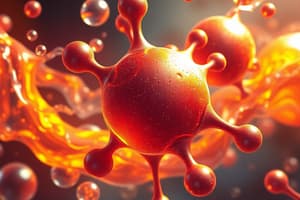Podcast
Questions and Answers
Which of the following is NOT a characteristic of acids?
Which of the following is NOT a characteristic of acids?
- Sour taste
- Release of hydroxide ions (OH-) when dissolved in water (correct)
- Essential for maintaining the pH balance in the human body
- pH less than 7
What is the property of bases that allows them to maintain the pH balance in the human body?
What is the property of bases that allows them to maintain the pH balance in the human body?
- pH greater than 7
- Formation of hydroxide ions (OH-) when dissolved in water (correct)
- Formation of hydrogen ions (H+) when dissolved in water
- Bitter taste
What happens to strong acids when dissolved in water?
What happens to strong acids when dissolved in water?
- They form a pH greater than 7
- They release hydrogen ions (H+) (correct)
- They completely dissociate into hydroxide ions (OH-) and their conjugate base
- They are not essential for maintaining the pH balance in the human body
In acid-base equilibria, what does the balance refer to?
In acid-base equilibria, what does the balance refer to?
Which common base is essential for the digestion of food?
Which common base is essential for the digestion of food?
Which of the following acids only partially dissociates into H+ ions and their conjugate base?
Which of the following acids only partially dissociates into H+ ions and their conjugate base?
What is the role of acid-base reactions?
What is the role of acid-base reactions?
What is the characteristic of strong bases when dissolved in water?
What is the characteristic of strong bases when dissolved in water?
Which system is an example of a buffer system?
Which system is an example of a buffer system?
Why is understanding acids and bases crucial for chemical reactions and processes?
Why is understanding acids and bases crucial for chemical reactions and processes?
Flashcards are hidden until you start studying
Study Notes
Chemistry Chapter 2: Acids and Bases
Introduction
Chemistry is a fascinating subject that deals with the properties, structure, and interactions of matter. In your class 10 chemistry course, you'll learn about various topics, one of which is acids and bases. Understanding this fundamental concept will help you grasp other chemical reactions and processes.
Acids
Acids are substances that have a sour taste, release hydrogen ions (H+) when dissolved in water, and have a pH less than 7. They are essential for maintaining the pH balance in the human body and for many other biological processes. Common acids include acetic acid, citric acid, and hydrochloric acid.
Bases
Bases are substances that have a bitter taste, form hydroxide ions (OH-) when dissolved in water, and have a pH greater than 7. They are essential for many biological processes, including the digestion of food and the maintenance of the pH balance in the human body. Common bases include sodium hydroxide and potassium hydroxide.
Acid-Base Equilibria
Acid-base equilibria refer to the balance between the concentration of H+ ions and OH- ions in a solution. This balance is essential for the proper functioning of many biological processes. Acid-base reactions involve the transfer of a proton (H+) from one molecule to another, creating an acid-base pair.
Strong and Weak Acids
Strong acids completely dissociate into H+ ions and their conjugate base when dissolved in water. Examples of strong acids include hydrochloric acid and nitric acid. On the other hand, weak acids only partially dissociate into H+ ions and their conjugate base when dissolved in water. Examples of weak acids include acetic acid and citric acid.
Strong and Weak Bases
Strong bases completely dissociate into OH- ions and their conjugate acid when dissolved in water. Examples of strong bases include sodium hydroxide and potassium hydroxide. Weak bases only partially dissociate into OH- ions and their conjugate acid when dissolved in water. Examples of weak bases include ammonia and carbonates.
Acid-Base Reactions
Acid-base reactions involve the transfer of a proton (H+) from one molecule to another, creating an acid-base pair. These reactions are crucial for various biological processes, including the digestion of food and the maintenance of the pH balance in the human body.
Buffers
Buffers are substances that help maintain a constant pH in a solution. They are essential for regulating the pH balance in the human body and in many other biological processes. Common buffer systems include the carbonate-bicarbonate system and the phosphate system.
Conclusion
Understanding the basics of acids and bases is crucial for grasping many chemical reactions and processes. By learning about acids and bases in your class 10 chemistry course, you'll gain a solid foundation in this fundamental concept that will serve you well in your future studies and career in the field.
Studying That Suits You
Use AI to generate personalized quizzes and flashcards to suit your learning preferences.




